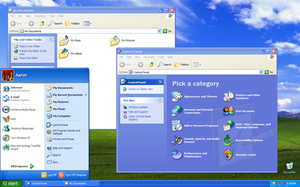"Release early, release often." This is the Web 2.0 mantra, and it's also a major guiding principle behind agile development proceses.
In product development, conventional wisdom has it that first-to-market- or first-mover advantage is hugely important. But for software products, this can kill you by painting your product into a corner from which it never recovers. Just about every software product is burdened with backward compatibility issues, and for many products, compatibility is paramount as customers create files with these products, integrate them into their environments, and come to depend on the software acting the way it does.
With its very first release, then, a software company can find itself wearing an anchor. Let's look at some examples.
Microsoft Windows
Windows is the definitive example of a product that's become hamstrung by backward compatibility. Compatibility was one of the things that killed Vista. It turns out that you can only slap so many coats of paint over a dry-rotted wall before you need to rebuild the frame. Even security (another noted weakness) would be better if Microsoft had really had the option to start over.
In the mean time, Apple was able to come out with a fresh operating system, and they're now cleaning Microsoft's clock in high-end systems.
Smartphones
Let's look at another example: smartphones. Palm and Blackberry were the first big players in this market, and Windows Mobile came along after that. Since those early days, all three of these OS's have remained essentially the same, and that's now causing them to look very, very dated. The iPhone, and to a lesser degree, Google's Android, are eating their lunch.
Palm's situation had gotten so dire, in fact, that many predicted their demise. Out of this desperation, though, Palm launched the Pre, which (surprise) is based on a brand-new OS. This isn't a coincidence: Palm simply wouldn't have been able to get to the Pre by migrating PalmOs incrementally, taking care not to ruffle any feathers along the way.
Lessons Learned
These disruptive changes are risky. Again, it's not surprising that it took a near-collapse on Palm's part to force them to roll the big dice on the Pre. This is a bet-the-company move for Palm, and they couldn't find the stones to make this move until they had little to lose by failing. This is not to say that I blame them; on the contrary, it's really an acknowledgment that it's a truly bold move to see companies innovating like this when they're still on top.
So what's the lesson here?
Simple. When you make platform decisions, understand that you're going to be sticking with them for a while. Your designs and decisions have the potential to stick around and haunt you for a very long time. But when you do determine that it's time for a change, you need to be able to cut the chains and move on every once in a while.
It's never too late to learn. Microsoft is demonstrating that they've learned this lesson (to some extent) in Windows 7. They've just announced that they're going to include a virtualized, licensed copy of Windows XP so that users can run old software in that old OS. Not only will this make the customers happy (because the can keep their old apps), it also sets the stage for Microsoft to finally kick some of that old OS compatibility code to the curb. Good riddance.
What's the albatross around your neck? What's it going to take for you to finally get rid of it?


![Reblog this post [with Zemanta]](https://i0.wp.com/img.zemanta.com/reblog_e.png?w=525)



 Yesterday, I learned that there's hope, after all.
Yesterday, I learned that there's hope, after all.


